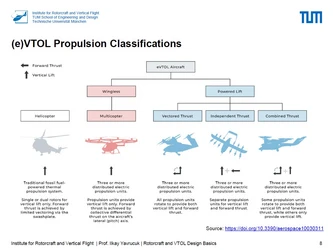Rotorcraft and VTOL Engineering requires an interaction between a number of different disciplines like aerodynamics, flight mechanics, structural engineering, design etc. This lecture addresses the fundamental correlations that play a role in preliminary design. It will be shown how to dimension main helicopter components based on mission requirements. Building on this, the iteration steps to further refining of the design will be explained. At the end of this lecture the participants will have basic knowledge for the preliminary design of a helicopter. This includes the estimation of empty weight and maximum take-off weight, installed power, flight envelope as well as the main- and tail-rotor sizing.
Course Content
- Introduction: Development history, designs, configurations, typical missions
- Fundamentals of flight physics: Introduction to momentum theory, hovering flight, climbing flight, forward flight, autorotation, ground effect, fundamentals of blade element theory
- Power requirements: Hovering flight, forward flight, power corrections
- Mission consumption: Standard atmosphere, specific fuel consumption, electrical consumption, determination of mission fuel
- Design based on missions: Design cycle, mass loop, parameter studies, carpet plots
- Design: Empty weight estimation, centre of gravity determination, main systems, total weight estimation
- Rotor design: Types, rotor parameters, rotor limits, control
- Rotor dynamics
- eVTOL: Design, batteries, fuel cells
